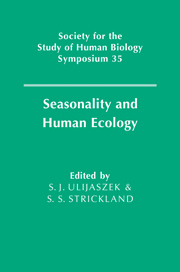Book contents
- Frontmatter
- Contents
- List of contributors
- Acknowledgements
- 1 Introduction
- 2 Seasonality and human biology
- 3 The influence of seasonality on hominid evolution
- 4 Environmental temperature and physiological function
- 5 Physiological responses to variations in daylength
- 6 Seasonality and fertility
- 7 Seasonality of reproductive performance in rural Gambia
- 8 Seasonal effects on physical growth and development
- 9 Seasonal variation in the birth prevalence of polygenic multifactorial diseases
- 10 Environment, season and infection
- 11 Seasonal mortality in the elderly
- 12 Nutritional seasonality: the dimensions of the problem
- 13 Seasonal variation in nutritional status of adults and children in rural Senegal
- 14 Culture, seasons and stress in two traditional African cultures (Massa and Mussey)
- 15 Agriculture, modernisation and seasonality
- 16 Seasonal organisation of work patterns
- Index
12 - Nutritional seasonality: the dimensions of the problem
Published online by Cambridge University Press: 23 January 2010
- Frontmatter
- Contents
- List of contributors
- Acknowledgements
- 1 Introduction
- 2 Seasonality and human biology
- 3 The influence of seasonality on hominid evolution
- 4 Environmental temperature and physiological function
- 5 Physiological responses to variations in daylength
- 6 Seasonality and fertility
- 7 Seasonality of reproductive performance in rural Gambia
- 8 Seasonal effects on physical growth and development
- 9 Seasonal variation in the birth prevalence of polygenic multifactorial diseases
- 10 Environment, season and infection
- 11 Seasonal mortality in the elderly
- 12 Nutritional seasonality: the dimensions of the problem
- 13 Seasonal variation in nutritional status of adults and children in rural Senegal
- 14 Culture, seasons and stress in two traditional African cultures (Massa and Mussey)
- 15 Agriculture, modernisation and seasonality
- 16 Seasonal organisation of work patterns
- Index
Summary
The nutritional status of rural communities in developing countries is believed to undergo seasonal deterioration as a consequence of food shortages occurring during the months preceding the harvest (Teokul et al., 1986). This is a time when food stores are at their lowest, often coinciding with the peak in demand for agricultural labour. This phenomenon is well known and the period is often referred to as the ‘hungry season’. Seasonal epidemics of infectious and parasitic diseases may coincide with these periods and induce secondary forms of malnutrition. These affect mostly the vulnerable sectors of the community, namely children and pregnant women. Although primary and secondary seasonal malnutrition potentially overlap, this article will address solely the primary form. Moreover, only adult energy deficiency will be considered, leaving out of the discussion children, as well as any other form of nutritional deficiency.
In this article, the evidence for seasonal weight loss will be updated and a numerical estimate of the global dimensions of seasonal energy stress will be attempted. This will be performed by an integrated analysis of agro-climatic information provided by the seasonality index and of biological information derived from the anthropometric assessment of nutritional status.
Seasonal body weight loss in the Third World
A review of the causes and occurrence of seasonality of energy metabolism in the Third World was presented at the first IDECG meeting in Guatemala about five years ago (Ferro–Luzzi et al., 1987). On that occasion a tentative mapping of the occurrence and extent of seasonality in the world was obtained by combining absolute and relative seasonality indices in a single seasonality index (SI).
- Type
- Chapter
- Information
- Seasonality and Human Ecology , pp. 149 - 165Publisher: Cambridge University PressPrint publication year: 1993
- 24
- Cited by

